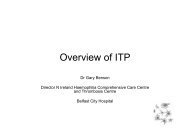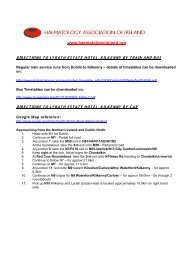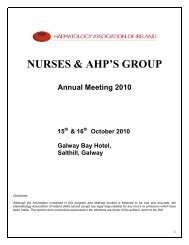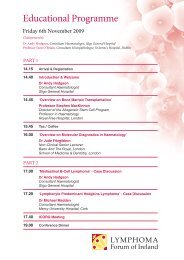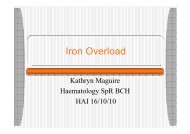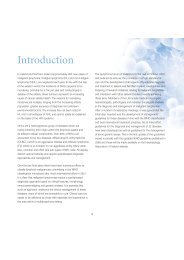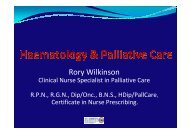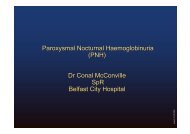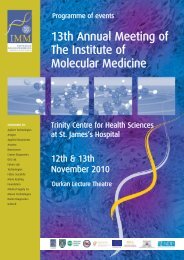Guidelines on Diagnosis and Treatment of Malignant Lymphomas
Guidelines on Diagnosis and Treatment of Malignant Lymphomas
Guidelines on Diagnosis and Treatment of Malignant Lymphomas
Create successful ePaper yourself
Turn your PDF publications into a flip-book with our unique Google optimized e-Paper software.
Alternatively, there may be an aberrant T-cell phenotype with<br />
decreased or absent pan T Markers (CD2, CD3, or CD5), absent<br />
T subset antigen expressi<strong>on</strong> (CD4, CD8), co-expressi<strong>on</strong> <strong>of</strong><br />
CD4+ <strong>and</strong> CD8+ or decreased or absent CD7. A CD8 +<br />
phenotype has been reported more comm<strong>on</strong>ly in paediatric MF.<br />
In Sezary Syndrome, tumour cells are CD2+, CD3+, TCR Beta+,<br />
CD5+ <strong>and</strong> CD7+/-. Most cases are CD4+ <strong>and</strong> expressi<strong>on</strong> <strong>of</strong><br />
CD8 is rare. Dem<strong>on</strong>strati<strong>on</strong> <strong>of</strong> a cl<strong>on</strong>al rearrangement <strong>of</strong> TCRs in<br />
peripheral blood T-cells may be diagnostically useful.<br />
Genetics<br />
T cell receptor genes are cl<strong>on</strong>ally rearranged in most cases.<br />
Complex karyotypic changes are <strong>of</strong>ten present, especially in<br />
advanced stages.<br />
Staging<br />
Clinical Staging system for cutaneous T-cell lymphoma<br />
Bunn & Lambert system<br />
Stage IA:<br />
Stage IB:<br />
T1 N0<br />
T2 N0<br />
Stage IIA: T1/2 N1<br />
Stage IIB: T3 N0/1<br />
Stage III: T4 N0/1<br />
Stage IVA: T-any N2/3<br />
Stage IVB: T-any N-any M1<br />
Recommended Investigati<strong>on</strong>s<br />
All patients except those with early stage mycosis fungoides (IA)<br />
should be reviewed by a multidisciplinary team including a<br />
dermatologist, haematologist or <strong>on</strong>cologist <strong>and</strong> dermatopathologist.<br />
The following are recommended:<br />
TNM classificati<strong>on</strong><br />
T1: Patches or plaques 10% body surface area<br />
T3: Tumours<br />
T4: Erythroderma<br />
N0: No palpable nodes<br />
N1: Palpable nodes without histological<br />
involvement (dermatopathic)<br />
N2: N<strong>on</strong> palpable nodes with histological involvement<br />
N3: Palpable nodes with histological involvement<br />
M0: No visceral disease<br />
M1: Visceral disease<br />
B0: No haematological involvement<br />
B1: Sézary cell count >5% <strong>of</strong> total peripheral<br />
blood lymphocytes.<br />
■<br />
■<br />
■<br />
■<br />
■<br />
■<br />
Generic investigati<strong>on</strong>s.<br />
History <strong>and</strong> physical examinati<strong>on</strong>, including whole body<br />
mapping <strong>of</strong> skin lesi<strong>on</strong>s.<br />
Peripheral blood film <strong>and</strong> immunophenotyping to diagnose<br />
Sézary <strong>and</strong> exlude other T cell leukaemias<br />
Human T-cell lymphotropic virus (HTLV)-1 serology<br />
to exclude ATLL<br />
T-cell receptor (TCR) gene analysis <strong>of</strong> peripheral blood<br />
may be useful.<br />
Skin Biopsy: If MF is suspected multiple (2-3) skin biopsies<br />
from different lesi<strong>on</strong>s should be taken. Fungal infecti<strong>on</strong><br />
should be excluded by a special stain (PAS). Repeated skin<br />
biopsies (ellipse in preference to punch) are <strong>of</strong>ten required to<br />
c<strong>on</strong>firm a diagnosis <strong>of</strong> CTCL. Histology, immunophenotyping<br />
(CD3, CD4, CD8, CD30) <strong>and</strong> preferably TCR gene analysis<br />
should be performed <strong>on</strong> representative tissue samples<br />
51



